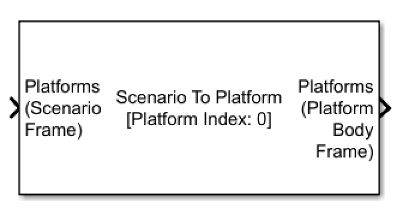Scenario To Platform

라이브러리:
Sensor Fusion and Tracking Toolbox /
Tracking Scenario and Sensor Models
설명
Scenario To Platform 블록은 시나리오 프레임에 표현된 플랫폼 자세를 플랫폼 바디 프레임에 표현된 플랫폼 자세로 변환합니다.
포트
입력
시나리오 프레임에 표현된 플랫폼 자세로, MATLAB 구조체가 포함된 Simulink 버스로 지정됩니다. 버스에 대한 자세한 내용은 Create Nonvirtual Buses (Simulink) 항목을 참조하십시오. 구조체에는 다음 필드가 있습니다.
| 필드 | 설명 |
|---|---|
NumPlatforms | 플랫폼 개수로, 음이 아닌 정수로 지정됩니다. |
Platforms | 시나리오 프레임에서의 플랫폼 자세로, 플랫폼 자세 구조체로 구성된 배열로 지정됩니다. 블록은 NumPlatforms에 지정된 플랫폼 개수만큼의 플랫폼 자세만 읽어옵니다. |
각 플랫폼 자세 구조체의 필드는 다음과 같습니다.
| 필드 | 설명 |
|---|---|
PlatformID | 플랫폼의 고유 식별자로, 양의 정수로 지정됩니다. |
ClassID | 타깃 유형을 분류하는 데 사용되는 사용자 정의 정수로, 음이 아닌 정수로 지정됩니다. |
Position | 시나리오 프레임에서의 플랫폼 위치로, 실수 값 1×3 벡터로 지정됩니다. 단위는 미터입니다. |
Velocity | 시나리오 프레임에서의 플랫폼 속도로, 실수 값 1×3 벡터로 지정됩니다. 단위는 초당 미터입니다. |
Acceleration | 시나리오 프레임에서의 플랫폼 가속도로, 실수 값 1×3 벡터로 지정됩니다. 단위는 제곱 초당 미터입니다. |
Orientation | 시나리오 프레임에 대한 플랫폼 방향으로, 3×3 회전 행렬로 지정됩니다. 방향은 시나리오 프레임에서 플랫폼 바디 프레임까지의 프레임 회전을 정의합니다. |
AngularVelocity | 시나리오 프레임에서의 플랫폼 각속도로, 실수 값 1×3 벡터로 지정됩니다. 벡터의 크기가 각속도를 정의합니다. 단위는 초당 도입니다. |
타깃 플랫폼 자세를 직접 지정하는 대신 Tracking Scenario Reader 블록을 사용하여 시나리오 프레임에 표현된 플랫폼 자세를 생성할 수 있습니다.
시나리오 프레임에 표현된 기준 플랫폼 자세로, MATLAB 구조체가 포함된 Simulink 버스로 지정됩니다. 버스에 대한 자세한 내용은 Create Nonvirtual Buses (Simulink) 항목을 참조하십시오. 구조체에는 다음 필드가 있습니다.
| 필드 | 설명 |
|---|---|
PlatformID | 플랫폼의 고유 식별자로, 양의 정수로 지정됩니다. 지정된 |
ClassID | 타깃 유형을 분류하는 데 사용되는 사용자 정의 정수로, 음이 아닌 정수로 지정됩니다. |
Position | 시나리오 프레임에서의 플랫폼 위치로, 실수 값 1×3 벡터로 지정됩니다. 단위는 미터입니다. 이 필드는 디폴트 값이 없는 필수 필드입니다. |
Velocity | 시나리오 프레임에서의 플랫폼 속도로, 실수 값 1×3 벡터로 지정됩니다. 단위는 초당 미터입니다. 이 필드는 디폴트 값이 없는 필수 필드입니다. |
Acceleration | 시나리오 프레임에서의 플랫폼 가속도로, 1×3 벡터로 지정됩니다. 단위는 제곱 초당 미터입니다. 이 필드는 디폴트 값이 없는 필수 필드입니다. |
Orientation | 시나리오 프레임에 대한 플랫폼 방향으로, 3×3 회전 행렬로 지정됩니다. 방향은 시나리오 프레임에서 플랫폼 바디 프레임까지의 프레임 회전을 정의합니다. 이 필드는 디폴트 값이 없는 필수 필드입니다. |
AngularVelocity | 시나리오 프레임에서의 플랫폼 각속도로, 1×3 실수값 벡터로 지정됩니다. 벡터의 크기가 각속도를 정의합니다. 단위는 초당 도입니다. 이 필드는 디폴트 값이 없는 필수 필드입니다. |
종속성
이 포트를 활성화하려면 기준 플랫폼 자세 입력값 활성화 체크박스를 선택하십시오.
출력
기준 플랫폼의 바디 프레임에 표현된 타깃 플랫폼 자세로, MATLAB 구조체가 포함된 Simulink 버스로 지정됩니다. 버스에 대한 자세한 내용은 Create Nonvirtual Buses (Simulink) 항목을 참조하십시오. 기준 플랫폼은 PlatformID가 기준 플랫폼 인덱스 파라미터에 지정된 플랫폼입니다. 구조체에는 다음 필드가 있습니다.
| 필드 | 설명 |
|---|---|
NumPlatforms | 플랫폼 개수로, 음이 아닌 정수로 지정됩니다. |
Platforms | 플랫폼 자세로, 플랫폼 자세 구조체로 구성된 배열로 지정됩니다. 블록은 NumPlatforms에 지정된 플랫폼 개수만큼의 플랫폼 자세만 읽어옵니다. |
각 플랫폼 자세 구조체에는 다음 필드가 있습니다.
| 필드 | 설명 |
|---|---|
PlatformID | 타깃 플랫폼의 고유 식별자로, 양의 정수로 반환됩니다. |
ClassID | 타깃 플랫폼 유형을 분류하는 데 사용되는 사용자 정의 정수로, 음이 아닌 정수로 반환됩니다. |
Position | 기준 플랫폼 바디 프레임에서의 타깃 플랫폼 위치로, 실수 값 1×3 벡터로 반환됩니다. 단위는 미터입니다. |
Velocity | 기준 플랫폼 바디 프레임에서의 타깃 플랫폼 속도로, 실수 값 1×3 벡터로 반환됩니다. 단위는 초당 미터입니다. 디폴트 값은 |
Acceleration | 기준 플랫폼 바디 프레임에서의 타깃 플랫폼 가속도로, 실수 값 1×3 벡터로 반환됩니다. 단위는 제곱 초당 미터입니다. 디폴트 값은 |
Orientation | 기준 플랫폼 바디 프레임에 대한 타깃 플랫폼 방향으로, 3×3 회전 행렬로 반환됩니다. 방향은 기준 플랫폼 바디 프레임에서 타깃 플랫폼 바디 프레임까지의 프레임 회전을 정의합니다. |
AngularVelocity | 기준 플랫폼 바디 프레임에서의 타깃 플랫폼 각속도로, 실수 값 1×3 벡터로 지정됩니다. 벡터의 크기가 각속도를 정의합니다. 단위는 초당 도입니다. |
이 출력값을 Fusion Radar Sensor 블록에 대한 입력값으로 사용할 수 있습니다.
파라미터
기준 플랫폼 인덱스로, 양의 정수로 지정됩니다. 이 인덱스에 대응하는 플랫폼 자세를 Platforms (Scenario Frame) 입력 포트 또는 Reference Platform Pose (Scenario Frame) 입력 포트를 통해 지정해야 합니다.
예: 1
Reference Platform Pose (Scenario Frame) 입력 포트를 활성화하려면 이 체크박스를 선택하십시오.
출력 버스 이름의 소스로, 다음 옵션 중 하나로 지정됩니다.
자동— 블록이 자동으로 버스 이름을 만듭니다.속성— 출력 버스 이름 지정 파라미터를 사용하여 버스 이름을 지정합니다.
출력 포트 버스 이름으로, 유효한 버스 이름으로 지정됩니다.
종속성
이 파라미터를 활성화하려면 출력 버스 이름의 소스 파라미터를 속성으로 설정하십시오.
다음 중 실행할 시뮬레이션 유형을 선택합니다.
인터프리터형 실행— MATLAB 인터프리터를 사용하여 모델을 시뮬레이션합니다. 이 옵션은 시작 시간을 줄입니다.인터프리터형 실행모드에서는 블록의 소스 코드를 디버그할 수 있습니다.코드 생성— 생성된 C 코드를 사용하여 모델을 시뮬레이션합니다. 시뮬레이션을 처음 실행하면 Simulink는 블록에 대한 C 코드를 생성합니다. 이 C 코드는 모델이 바꾸지 않는 한 후속 시뮬레이션에 재사용됩니다. 이 옵션은 시작 시간이 조금 더 걸립니다.
확장 기능
C/C++ 코드 생성
Simulink® Coder™를 사용하여 C 코드나 C++ 코드를 생성할 수 있습니다.
버전 내역
R2022b에 개발됨R2023a부터 이 블록이 생성하는 Simulink 버스는 더 이상 MATLAB 작업 공간에 표시되지 않습니다.
참고 항목
Tracking Scenario Reader | Fusion Radar Sensor | Create Nonvirtual Buses (Simulink)
MATLAB Command
You clicked a link that corresponds to this MATLAB command:
Run the command by entering it in the MATLAB Command Window. Web browsers do not support MATLAB commands.
웹사이트 선택
번역된 콘텐츠를 보고 지역별 이벤트와 혜택을 살펴보려면 웹사이트를 선택하십시오. 현재 계신 지역에 따라 다음 웹사이트를 권장합니다:
또한 다음 목록에서 웹사이트를 선택하실 수도 있습니다.
사이트 성능 최적화 방법
최고의 사이트 성능을 위해 중국 사이트(중국어 또는 영어)를 선택하십시오. 현재 계신 지역에서는 다른 국가의 MathWorks 사이트 방문이 최적화되지 않았습니다.
미주
- América Latina (Español)
- Canada (English)
- United States (English)
유럽
- Belgium (English)
- Denmark (English)
- Deutschland (Deutsch)
- España (Español)
- Finland (English)
- France (Français)
- Ireland (English)
- Italia (Italiano)
- Luxembourg (English)
- Netherlands (English)
- Norway (English)
- Österreich (Deutsch)
- Portugal (English)
- Sweden (English)
- Switzerland
- United Kingdom (English)